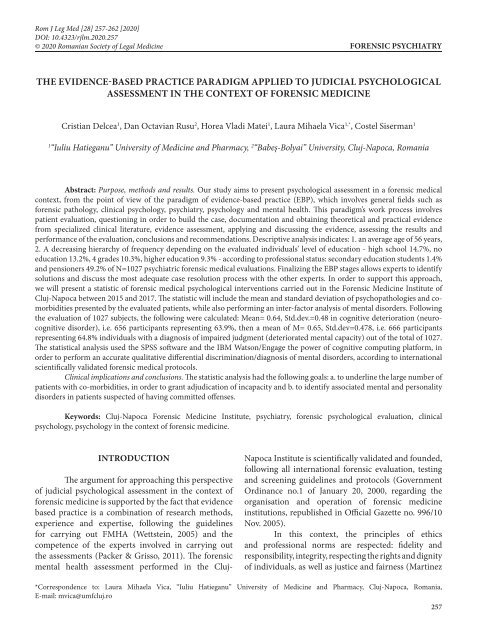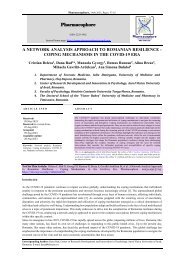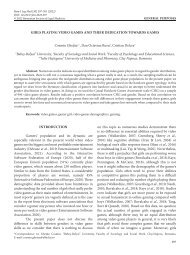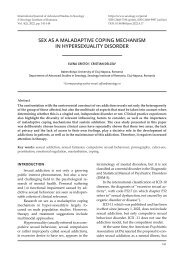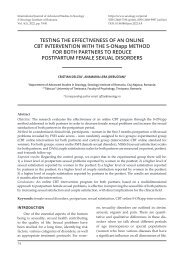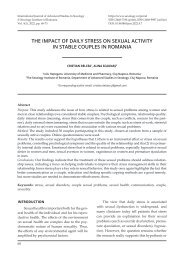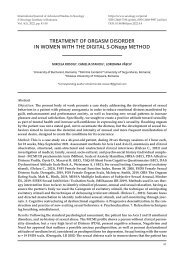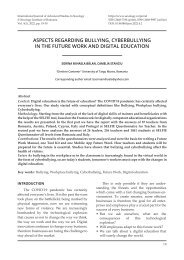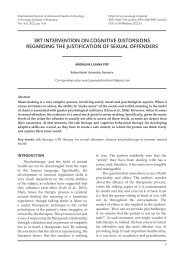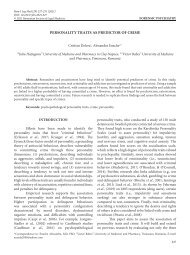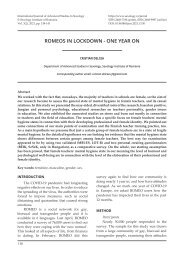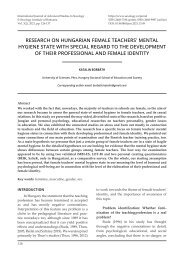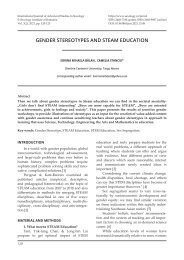THE EVIDENCE-BASED PRACTICE PARADIGM APPLIED TO JUDICIAL PSYCHOLOGICAL ASSESSMENT IN THE CONTEXT OF FORENSIC MEDICINE
Create successful ePaper yourself
Turn your PDF publications into a flip-book with our unique Google optimized e-Paper software.
Rom J Leg Med [28] 257-262 [2020]<br />
DOI: 10.4323/rjlm.2020.257<br />
© 2020 Romanian Society of Legal Medicine<br />
<strong>FORENSIC</strong> PSYCHIATRY<br />
<strong>THE</strong> <strong>EVIDENCE</strong>-<strong>BASED</strong> <strong>PRACTICE</strong> <strong>PARADIGM</strong> <strong>APPLIED</strong> <strong>TO</strong> <strong>JUDICIAL</strong> <strong>PSYCHOLOGICAL</strong><br />
<strong>ASSESSMENT</strong> <strong>IN</strong> <strong>THE</strong> <strong>CONTEXT</strong> <strong>OF</strong> <strong>FORENSIC</strong> MEDIC<strong>IN</strong>E<br />
Cristian Delcea 1 , Dan Octavian Rusu 2 , Horea Vladi Matei 1 , Laura Mihaela Vica 1,* , Costel Siserman 1<br />
1<br />
“Iuliu Hatieganu” University of Medicine and Pharmacy, 2 “Babeș-Bolyai” University, Cluj-Napoca, Romania<br />
Abstract: Purpose, methods and results. Our study aims to present psychological assessment in a forensic medical<br />
context, from the point of view of the paradigm of evidence-based practice (EBP), which involves general fields such as<br />
forensic pathology, clinical psychology, psychiatry, psychology and mental health. This paradigm’s work process involves<br />
patient evaluation, questioning in order to build the case, documentation and obtaining theoretical and practical evidence<br />
from specialized clinical literature, evidence assessment, applying and discussing the evidence, assessing the results and<br />
performance of the evaluation, conclusions and recommendations. Descriptive analysis indicates: 1. an average age of 56 years,<br />
2. A decreasing hierarchy of frequency depending on the evaluated individuals’ level of education - high school 14.7%, no<br />
education 13.2%, 4 grades 10.3%, higher education 9.3% - according to professional status: secondary education students 1.4%<br />
and pensioners 49.2% of N=1027 psychiatric forensic medical evaluations. Finalizing the EBP stages allows experts to identify<br />
solutions and discuss the most adequate case resolution process with the other experts. In order to support this approach,<br />
we will present a statistic of forensic medical psychological interventions carried out in the Forensic Medicine Institute of<br />
Cluj-Napoca between 2015 and 2017. The statistic will include the mean and standard deviation of psychopathologies and comorbidities<br />
presented by the evaluated patients, while also performing an inter-factor analysis of mental disorders. Following<br />
the evaluation of 1027 subjects, the following were calculated: Mean= 0.64, Std.dev.=0.48 in cognitive deterioration (neurocognitive<br />
disorder), i.e. 656 participants representing 63.9%, then a mean of M= 0.65, Std.dev=0.478, i.e. 666 participants<br />
representing 64.8% individuals with a diagnosis of impaired judgment (deteriorated mental capacity) out of the total of 1027.<br />
The statistical analysis used the SPSS software and the IBM Watson/Engage the power of cognitive computing platform, in<br />
order to perform an accurate qualitative differential discrimination/diagnosis of mental disorders, according to international<br />
scientifically validated forensic medical protocols.<br />
Clinical implications and conclusions. The statistic analysis had the following goals: a. to underline the large number of<br />
patients with co-morbidities, in order to grant adjudication of incapacity and b. to identify associated mental and personality<br />
disorders in patients suspected of having committed offenses.<br />
Keywords: Cluj-Napoca Forensic Medicine Institute, psychiatry, forensic psychological evaluation, clinical<br />
psychology, psychology in the context of forensic medicine.<br />
<strong>IN</strong>TRODUCTION<br />
The argument for approaching this perspective<br />
of judicial psychological assessment in the context of<br />
forensic medicine is supported by the fact that evidence<br />
based practice is a combination of research methods,<br />
experience and expertise, following the guidelines<br />
for carrying out FMHA (Wettstein, 2005) and the<br />
competence of the experts involved in carrying out<br />
the assessments (Packer & Grisso, 2011). The forensic<br />
mental health assessment performed in the Cluj-<br />
Napoca Institute is scientifically validated and founded,<br />
following all international forensic evaluation, testing<br />
and screening guidelines and protocols (Government<br />
Ordinance no.1 of January 20, 2000, regarding the<br />
organisation and operation of forensic medicine<br />
institutions, republished in Official Gazette no. 996/10<br />
Nov. 2005).<br />
In this context, the principles of ethics<br />
and professional norms are respected: fidelity and<br />
responsibility, integrity, respecting the rights and dignity<br />
of individuals, as well as justice and fairness (Martinez<br />
*Correspondence to: Laura Mihaela Vica, “Iuliu Hatieganu” University of Medicine and Pharmacy, Cluj-Napoca, Romania,<br />
E-mail: mvica@umfcluj.ro<br />
257
Delcea C. et al.<br />
& Candilis, 2011, p. 60; Allan, Grisso, 2014). The<br />
forensic medical committee team consists of a forensic<br />
pathologist, two psychiatrists and a psychologist, with<br />
high academic training, competence and experience<br />
in the field. Psychiatric forensic examination is an<br />
applicative field of psychiatry, forensic medicine, but<br />
also of psychology, in the area of psycho-pathologically<br />
motivated antisocial acts. It aims to outline a clinical<br />
picture, in order to answer requests from a judicial<br />
court or family member, and/or in order to generate<br />
acts of disposition. The evaluation method consists of<br />
studying the documents on file, a clinical interview, as<br />
well as psychological testing with scientifically validated<br />
adapted instruments, recognised by the Romanian<br />
College of Psychologists.<br />
MATERIALS AND METHODS<br />
The procedure used was file analysis, psychiatric<br />
evaluation, clinical interview and psychological testing,<br />
all according to the legal norms and procedures and<br />
respecting all international forensic evaluation, testing<br />
and screening guidelines and protocols (Government<br />
Ordinance no.1 of January 20, 2000, regarding the<br />
organisation and operation of forensic medicine<br />
institutions, republished in Official Gazette no. 996/10<br />
nov.2005, and the guidelines issued by the Romanian<br />
College of Psychologists in 2004 and subsequently).<br />
Work instruments and materials:<br />
- Standard Progressive Matrices MPRS was<br />
created in order to assess the intelligence of individuals<br />
aged between 6 and 80. The test was applied to 645<br />
patients of the total of 1027. The average IQ is 65.<br />
- The Cognitive Aptitude Psychological Test<br />
battery consists of 23 tests and is a new generation of<br />
psychological tests. The test was applied to 702 patients<br />
of the total 1027. The BTPAC average is 17.14.<br />
- The psychological tasks which form part of<br />
SEC (addressed to adults, children or adolescents) were<br />
selected starting from the paradigm of scientifically<br />
validated psychodiagnosis and clinical evaluation. The<br />
test was applied to 1023 patients of the total of 1027,<br />
and the SEC average is 40.16.<br />
- The Global Deterioration Scale (GDS),<br />
validated by Reisberg B, Fewrris SH, de Leon MJ,<br />
Crook T (1982), published in the American Journal of<br />
Psychiatry 139: 1136-9. Was applied to 129 patients of<br />
the total of 1027, and the GDS average is 4.85.<br />
- Mini-Mental State Examination, Second<br />
Edition (MMSE) is a standardised clinical examination<br />
for the evaluation of cognitive deterioration, being<br />
considered as one of the most popular and trustworthy<br />
instruments of its kind. The test was applied to 481<br />
patients of the total of 1027, and the MMSE average is<br />
16.05.<br />
- Functional assessment staging (FAST) in<br />
Alzheimer was applied to 86 patients of the total of<br />
1027, and the FAST average is 4.81.<br />
- The Eysenck Personality Questionnaire<br />
(EPQ), in its revised form, was applied to 61 patients of<br />
the total of 1027. The EPQ average is 52.95.<br />
- Hare Psychopathy Checklist-Revised has<br />
become, ever since its first edition in 1991, the defining<br />
standard in the evaluation of psychopathic personality.<br />
The test was applied to 60 of the total of 1027, and the<br />
PCL-R average is 33.5.<br />
- ABAS provides a comprehensive evaluation,<br />
based on carefully selected norms, of a person’s adaptive<br />
abilities. The test was applied to 404 patients of the total<br />
of 1027, and the ABAS average is 45.67.<br />
- Minnesota Multiphasic Personality<br />
Inventory-2 is the best known and most used instrument<br />
for the diagnosis and evaluation of adult personality<br />
and psychopathology in the clinical environment or in<br />
research. The test was applied to 15 patients of the total<br />
of 1027, and the MMPI average is 37.67.<br />
- Millon® Clinical Multiaxial Inventory-III<br />
(MCMI-III) is a psychometric instrument meant<br />
to provide information regarding psychopathology,<br />
including disorders included in the DSM-V. The test<br />
was applied to 47 patients of the total of 1027, and the<br />
MCMI-III average is 40.87.<br />
- State-Trait Anxiety Inventory (Form Y) is the<br />
revised and improved version of the STAI inventory,<br />
Form X, which is considered by many to be the most<br />
well made psychometric instrument for the evaluation<br />
of anxiety. The test was applied to 9 patients of the total<br />
of 1027, and the STAI average is 36.11.<br />
- The YSQ test was applied to 6 patients of the<br />
total of 1027, the YSQ average being 58.5.<br />
- The ZKPQ questionnaire was elaborated adhoc<br />
in order to assess the defining dimensions of the<br />
Alternative Five-Factor Model – AFFM: Impulsive thrill<br />
seeking; Sociability; Neuroticism– anxiety; Aggression<br />
– hostility; Activity. The test was applied to 4 patients of<br />
the total of 1027, obtaining a ZKPQ average of 39.15.<br />
- The Beck Depression Inventory – second<br />
edition (BDI - II) is a self assessment instrument<br />
consisting of 21 items, built to measure the severity of<br />
depression in adults and adolescents over 13 years old.<br />
The test was applied to 10 patients of the total of 1027,<br />
and the BDI average obtained is 15.<br />
258
The evidence-based practice paradigm applied to judicial psychological assessment in the context of forensic medicine<br />
- Millon Adolescent Clinical Inventory (MACI)<br />
is a self assessment inventory specifically created for<br />
evaluating personality traits and clinical syndromes in<br />
adolescents. The test was applied to 1 patient of the total<br />
of 1027, obtaining a MACI score of 63.<br />
- The OMNI-IV Inventory of Personality<br />
Disorders is an instrument which allows the self<br />
assessment of specific disorders on Axis II of the DSM-<br />
IV. The test was applied to 10 patients of the total of<br />
1027, and the OMNI average obtained is 46.44.<br />
Participants<br />
The results presented in the Figure 1 indicate<br />
an average age of 56 years. Table 1 details the frequency<br />
Figure 1. Descriptive results regarding the age of participants in<br />
evaluation and testing.<br />
and validation of the age average of the participants in<br />
evaluation and testing performed by the committees of<br />
Cluj-Napoca Forensic Medicine Institute.<br />
The descriptive results regarding year of<br />
psychological evaluation and testing are presented in<br />
Table 1.<br />
The education level can be summarised as<br />
follows: high school 14.7%, zero grades 13.2%, 4 grades<br />
10.3%, higher education 9.3%, while according to their<br />
professional status, 1.4% were secondary students and<br />
49.2% were pensioners out of the total N=1027.<br />
RESULTS<br />
Descriptive results regarding comorbidities<br />
The results show that 656 cases of the total 1027<br />
fall under cognitive deterioration (neuro-cognitive<br />
disorder). Table 2 details frequency and mean validation<br />
in cognitive deterioration for the participants to the<br />
psychological evaluation and testing performed by the<br />
committees of IML Cluj.<br />
Therefore, we have 666 participants with a<br />
diagnosis of impaired judgment (deteriorated mental<br />
capacity) out of the total of 1027 psychiatric forensic<br />
examinations performed. Table 3 details the frequency<br />
and mean validation for the participants’ mental<br />
capacity.<br />
Table 1. Frequency and validation of age mean for the participants<br />
Year of examination<br />
Frequency Percent Valid Percent Cumulative Percent<br />
2015 320 31.2 31.2 31.2<br />
2016 349 34.0 34.0 65.3<br />
Valid<br />
2017 297 28.9 29.0 94.2<br />
2018 59 5.7 5.8 100.0<br />
Total 1025 99.8 100.0<br />
Missing System 2 0.2<br />
Total 1027 100.0<br />
Table 2. Descriptive results regarding cognitive deterioration<br />
Valid<br />
Deterioration<br />
Frequency Percent Valid Percent Cumulative Percent<br />
0 371 36.1 36.1 36.1<br />
1 656 63.9 63.9 100.0<br />
Total 1027 100.0 100.0<br />
Table 3. Frequency and mean validation for mental capacity<br />
Valid<br />
Capacity<br />
Frequency Percent Valid Percent Cumulative Percent<br />
0 361 35.2 35.2 35.2<br />
1 666 64.8 64.8 100.0<br />
Total 1027 100.0 100.0<br />
259
Delcea C. et al.<br />
Descriptive results regarding cognitive deficit<br />
The degree of disability and eligibility for<br />
social services: developmental delay, biologic risk<br />
factors, cranial trauma, autism, ADHD, learning and<br />
behavioural disorders, sensory insufficiency, physical<br />
trauma or disability, poor health, motor impairment,<br />
emotional disorders, cerebral lesions, stroke, dementia,<br />
Alzheimer’s disease, substance abuse, psychotic<br />
disorders and multiple disabilities.<br />
Table 4 illustrates frequency and mean<br />
validation – where 0 is absence of deficit and 1 is<br />
presence of deficit – for the participants evaluated<br />
by the forensic psychiatric committees of IML Cluj<br />
Napoca.<br />
Descriptive results regarding social deficit<br />
The degree of disability and eligibility for<br />
social services: developmental delay, biologic risk<br />
factors, cranial trauma, autism, ADHD, learning and<br />
behavioural disorders, sensory insufficiency, physical<br />
trauma or disability, poor health, motor impairment,<br />
emotional disorders, cerebral lesions, stroke, dementia,<br />
Alzheimer’s disease, substance abuse, psychotic<br />
disorders and multiple disabilities.<br />
There are 647 cases of social deficit out of<br />
the total of 1027 forensic psychiatric examinations<br />
performed. Table 5 presents the frequency and mean<br />
validation – where 0 is absence of deficit and 1 is<br />
presence of deficit – for the participants evaluated<br />
by the forensic psychiatric committees of IML Cluj<br />
Napoca.<br />
Descriptive results regarding applicative/<br />
practical deficit<br />
The degree of disability and eligibility for<br />
social services: developmental delay, biologic risk<br />
factors, cranial trauma, autism, ADHD, learning and<br />
behavioural disorders, sensory insufficiency, physical<br />
trauma or disability, poor health, motor impairment,<br />
emotional disorders, cerebral lesions, stroke, dementia,<br />
Alzheimer’s disease, substance abuse, psychotic<br />
disorders and multiple disabilities.<br />
There are 642 cases of applicative/practical<br />
deficit out of the total of 1027 forensic psychiatric<br />
examinations performed. Table 6 shows the frequency<br />
and mean validation – where 0 is absence of deficit and<br />
1 is presence of deficit – for the participants evaluated<br />
by the forensic psychiatric committees of IML Cluj<br />
Napoca.<br />
Descriptive results regarding personality<br />
disorders<br />
There are 134 cases of personality disorders out<br />
of the total of 1027 forensic psychiatric examinations<br />
performed. Table 7 illustrates the frequency and mean<br />
validation – where 0 is absence of disorder and 1 is<br />
presence of disorder – for the participants evaluated<br />
by the forensic psychiatric committees of IML Cluj<br />
Napoca.<br />
Descriptive results regarding behavioural<br />
disorders<br />
There are 196 of behavioural disorders out<br />
of the total of 1027 forensic psychiatric examinations<br />
Table 4. Frequency and mean validation - 0 (absence of deficit)/ 1 (presence of deficit)<br />
Valid<br />
Deficit C<br />
Frequency Percent Valid Percent Cumulative Percent<br />
0 403 39.2 39.2 39.2<br />
1 624 60.8 60.8 100.0<br />
Total 1027 100.0 100.0<br />
Table 5. Frequency and mean validation for social deficit - 0 (absence of deficit)/ 1 (presence of deficit)<br />
Valid<br />
Deficit S<br />
Frequency Percent Valid Percent Cumulative Percent<br />
0 380 37.0 37.0 37.0<br />
1 647 63.0 63.0 100.0<br />
Total 1027 100.0 100.0<br />
Table 6. Frequency and mean validation for applicative/ practical deficit<br />
Valid<br />
260<br />
Deficit A<br />
Frequency Percent Valid Percent Cumulative Percent<br />
0 385 37.5 37.5 37.5<br />
1 642 62.5 62.5 100.0<br />
Total 1027 100.0 100.0
The evidence-based practice paradigm applied to judicial psychological assessment in the context of forensic medicine<br />
performed. Table 8 shows the frequency and mean<br />
validation – where 0 is absence of disorder and 1 is<br />
presence of disorder – for the participants evaluated<br />
by the forensic psychiatric committees of IML Cluj-<br />
Napoca.<br />
Descriptive results regarding schizophrenia<br />
spectrum<br />
There is a mean of 169 regarding the<br />
schizophrenia spectrum out of the total of 1027<br />
forensic psychiatric examinations performed. Table 9<br />
shows the frequency and mean validation – where 0 is<br />
absence of disorder and 1 is presence of disorder – for<br />
the participants evaluated by the forensic psychiatric<br />
committees of IML Cluj-Napoca.<br />
Descriptive results regarding adaptive<br />
participation in testing and evaluation<br />
There is a mean of 476 cases of maladaptive<br />
participation out of the total of 1027 forensic<br />
psychiatric examinations performed. Table 10 details<br />
the frequency and mean validation – where 0 is<br />
absence of maladaptive participation and 1 is presence<br />
of maladaptive participation – for the participants<br />
evaluated by the forensic psychiatric committees of<br />
IML Cluj-Napoca.<br />
Descriptive results regarding anxiety/<br />
depression disorder<br />
There is a mean of 1 anxiety/depression out<br />
of the total of 1027 forensic psychiatric examinations<br />
performed. Table 11 illustrates the frequency and mean<br />
validation – where 0 is absence of disorder and 1 is<br />
presence of disorder – for the participants evaluated<br />
by the forensic psychiatric committees of IML Cluj-<br />
Napoca.<br />
Table 7. Frequency and mean validation - 0 (absence of disorder)/ 1 (presence of disorder)<br />
Valid<br />
Personality<br />
Frequency Percent Valid Percent Cumulative Percent<br />
0 893 87.0 87.0 87.0<br />
1 134 13.0 13.0 100.0<br />
Total 1027 100.0 100.0<br />
Table 8. Frequency and mean validation - 0 (absence of behavioural disorder) / 1 (presence of behavioural disorder)<br />
Valid<br />
Behaviour<br />
Frequency Percent Valid Percent Cumulative Percent<br />
0 831 80.9 80.9 80.9<br />
1 196 19.1 19.1 100.0<br />
Total 1027 100.0 100.0<br />
Table 9. Frequency and rate of schizophrenia spectrum in the examined patients<br />
Valid<br />
Spectrum S<br />
Frequency Percent Valid Percent Cumulative Percent<br />
0 858 83.5 83.5 83.5<br />
1 169 16.5 16.5 100.0<br />
Total 1027 100.0 100.0<br />
Table 10. Frequency and mean validation regarding adaptive participation to testing<br />
Valid<br />
Maladaptive participation<br />
Frequency Percent Valid Percent Cumulative Percent<br />
0 551 53.7 53.7 53.7<br />
1 476 46.3 46.3 100.0<br />
Total 1027 100.0 100.0<br />
Table 11. Frequency and rate of anxiety/ depression disorder<br />
Anxiety/Depression<br />
Frequency Percent Valid Percent Cumulative Percent<br />
Valid 1 1 0.1 100.0 100,0<br />
Missing System 1026 99.9<br />
Total 1027 100.0<br />
261
Table 12. Frequency and rate of patient simulation/dissimulation<br />
Delcea C. et al.<br />
Simulates/dissimulates<br />
Frequency Percent Valid Percent Cumulative Percent<br />
Valid 1 4 0.4 100.0 100.0<br />
Missing System 1023 99.6<br />
Total 1027 100.0<br />
Descriptive results regarding simulation/<br />
dissimulation<br />
There is a mean of 4 participants with<br />
simulation/dissimulation out of the total of 1027<br />
forensic psychiatric examinations performed. Table 12<br />
illustrates the frequency and mean validation – where 0<br />
is absence of disorder and 1 is presence of disorder – for<br />
the participants evaluated by the forensic psychiatric<br />
committees of IML Cluj Napoca.<br />
DISCUSSION<br />
The results above show the existence of a<br />
larger rate of neurocognitive disorder, developmental<br />
intellectual disability and schizophrenia spectrum<br />
(psychotic disorders, schizophrenia and other associated<br />
mental disorders). A forensic model for the evidencebased<br />
practice (EBP) paradigm has been emphasised in<br />
the evaluation activity of the Cluj-Napoca Institute of<br />
Forensic Medicine.<br />
The results obtained by the members of the<br />
committee were in concordance with each other, but<br />
also with the results obtained from psychological<br />
testing. Consequently, no clarifications or discussions<br />
were required on the aspects which were evaluated/<br />
tested. There is a continuous preoccupation for the<br />
improvement of evaluation procedures, by increasing<br />
the duration of an examination and using more<br />
performant instruments and devices. For instance, in<br />
the case of paedophilia, we aim to purchase and use a<br />
modern device which can provide much more complex<br />
information for establishing differential diagnosis<br />
compared to the instruments which have been used up<br />
to now.<br />
Another goal is to use examination time<br />
more efficiently, aiming to increase the duration of<br />
an evaluation, in order to obtain relevant information<br />
which would converge in establishing a diagnosis or the<br />
conclusions of an examination.<br />
In conclusion, the results obtained within the<br />
evaluation committees show that, following legal and<br />
procedural norms, they have generated correct and<br />
just decisions for adjudication of incapacity until the<br />
clarification of comorbid psychopathology which may<br />
have remained unidentified in the initial evaluation<br />
which the patients had undergone before being<br />
examined by IML Cluj-Napoca.<br />
Using modern testing instruments, legal<br />
procedures and approaching the evidence based<br />
practice (EBP) paradigm are the resources and means<br />
by which psychological evaluation in the forensic field<br />
has a double role, both a complementary one and one<br />
of confirming psychiatric results.<br />
Conflict of interest<br />
The authors declare that they have no conflict of<br />
interest.<br />
References<br />
1. Edmond G, Found B, Martire K, Ballantyne K, Hamer D, Searston<br />
RA, Thompson MB, Cunliffe E, Kemp R, San Roque M, Tangen J,<br />
Dioso-Villa R, Ligertwood A, Hibbert B, White D, Porter G, Roberts<br />
A. Model forensic science. Australian Journal of Forensic Sciences.<br />
2016; 48(5): 496-537.<br />
2. Edmond G, Martire KA. Forensic science in criminal courts: The<br />
latest scientific insights. Australian Bar Review. 2016; 42(3): 367-<br />
384.<br />
3. Chin JM, Ribeiro G, Rairden A. Author Notes, Journal of Law and<br />
the Biosciences. 2019; 6 (1): 255–288.<br />
4. Ross R, Kramer K, Martire KA. Consistent with: what doctors<br />
say and jurors hear, Australian Journal of Forensic Sciences. 2019;<br />
51:1: 109-116.<br />
5. Martire KA, Edmond G. Rethinking expert opinion evidence.<br />
Melbourne University Law Review. 2017.<br />
6. Martire KA, Kemp RI, Newell BR. The psychology of interpreting<br />
expert evaluative opinions. Australian Journal of Forensic Sciences.<br />
2013; 45(3): 305-314.<br />
7. Styck KM, Walsh SM. Evaluating the prevalence and impact<br />
of examiner errors on the Wechsler scales of intelligence: a meta<br />
analysis. Psychol Assess. 2016; 28:3–17.<br />
8. Ordonanţă nr.1 din 20 ianuarie 2000 privind organizarea<br />
activităţiişifuncţionareainstituţiilor de medicină legală. Textul<br />
actului republicat în M.Of. nr. 996/10 noi. 2005, http://www.cdep.<br />
ro/pls/legis/legis_pck.htp_act_text?idt=67669 (Romanian).<br />
262


